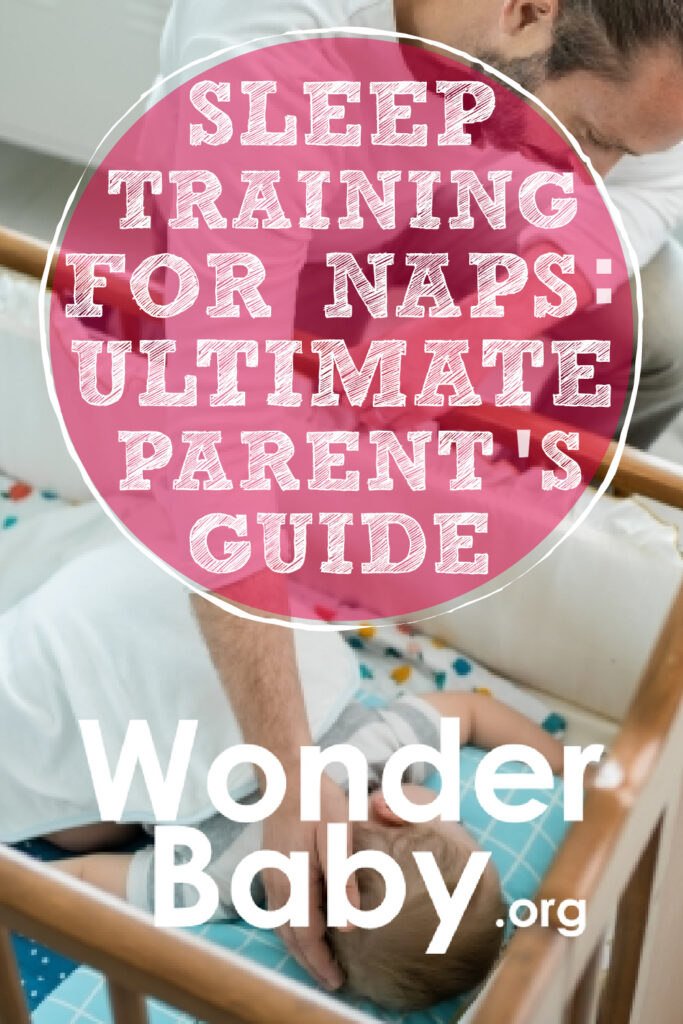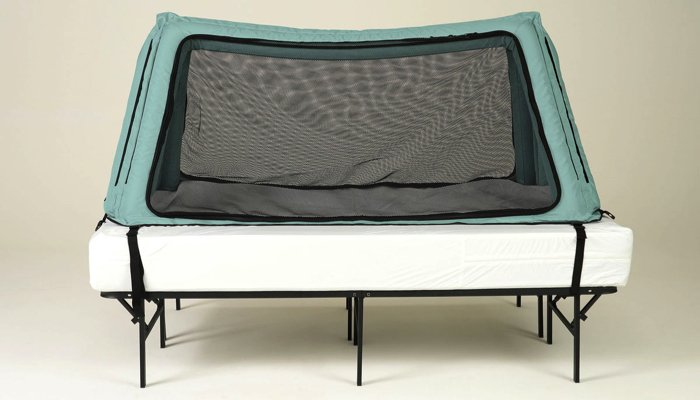Sleep Training for Naps: The Ultimate Guide for Parents

- Don’t attempt nap training before your baby is 4 months old.
- Sleep training can help your baby get enough sleep to develop at the right pace.
- Sleep training is practical, even for moms who don’t follow a routine.
- There are many different nap training methods, so you don’t have to let your baby cry it out.
Like many other moms, I used to flinch when I heard someone mention sleep training. My mind immediately raced to the thought of a baby being left on their own for hours until they eventually passed out. To my surprise, just the opposite is true when you follow gentle sleep training methods.
Sleep training received a bad reputation in the last couple of years, with moms being more vocal about their uninformed opinions on it. I was one of them! Ever since I became a work-from-home mom, I have learned that sleep training for naps is a true lifesaver.
When you nap train your baby, nap time runs smoother, and you get a little more time to be more than just a mom. The best part is that your baby also benefits, despite the many controversies doing the rounds.
No matter which parenting style you prefer, there’s a nap training method you can use. If you stay consistent and do what best suits your baby and family, you can teach your child to fall asleep independently with ease.
When Should I Sleep Train My Baby for Naps?
You should wait to sleep train your baby until they’re at least 4 months old. Sleep training is an effective way to teach your baby how to take daytime naps, but if you start too soon, they won’t be developmentally ready, and the process will tire you out!

Nap Sleep Training Tips
Sleep training methods for naptime aren’t much different than nighttime sleep training. If you want your little one to take an afternoon nap without struggling for an entire hour, use these daytime sleep tips to help them fall asleep.
Keep to a Schedule
You might not be a routine mom, and that’s okay! You can still implement a nap routine without completely changing how you raise your kids.
You’ll notice your baby gets fussy at certain times of the day, and this is typically a cue that it’s time for a short nap. Try your best to get ahead of this and minimize your plans for their sleeping window. You want to ensure that you have the perfect naptime environment for your baby when they start showing their sleepy cues.
Keep Busy Between Naps
Your child’s naps should be alternated with busy playtimes, but be careful to not overstimulate your baby.
Do age-appropriate activities with your baby between naps, and allow some independent play. Training your baby to sleep will be much easier if you help their bodies and brain tire out.
Set The Scene
You might prefer your baby’s room, but if they won’t sleep in their crib, you can choose another comfortable place where your child falls asleep.
A quiet room usually makes the perfect naptime environment. Some babies prefer noise, and as long as your child gets enough daytime sleep, where you put them down for a nap doesn’t matter.
Setting the right environment for your baby will help them fall asleep independently. If you notice them waking frequently, you should make some changes. Dark rooms, white noise, and familiar surroundings help most babies sleep better during the day.
Stay Ahead
No matter which sleep training method you choose, it won’t work if your baby is overtired or uncomfortable. You should stay ahead of their cues if you want them to fall asleep easier.
Before the time for their morning or afternoon nap comes around, put on a clean nappy and ensure your baby is well-fed. A baby naps longer when they don’t have to fight against hunger or dampness against their skin.
You don’t always need to wait for sleepiness cues to show. If you keep to a nap schedule, you can get your baby comfortable in time for their nap and help them fall asleep with ease.
Stay Consistent
Babies aren’t predictable, and sometimes they refuse to stick to their sleep schedule. It’s your job to stay consistent if you want your baby to establish a good sleep pattern. You can’t force your baby to sleep, but you can help them find comfort in their naptime routine.
A sleep training plan will work once you figure out your baby’s preference and stick to it. Don’t sing them a lullaby today and keep them in silence tomorrow. You should choose a sleep training method that you know you can sustain.
Benefits of Sleep Training for Naps
Newborns sleep more than they’re awake, but once they hit 4 months, you’ll notice them staying active for longer before their next nap. Short naps between playtime become important around this age, and sleep training can help your baby establish healthy sleep patterns.
Benefits For Babies
- Improves Sleep Quality: Babies who fall asleep on their own know how to self-soothe. If they wake, they can go back to sleep without your help, allowing them to sleep longer and improve their sleep cycle.
- Improves Nighttime Sleep: Nap training can help your baby sleep better at night. When babies sleep during the day, they won’t be overtired during their bedtime routine, and falling asleep will be more peaceful.
- Improves Moods: A child’s sleep pattern directly influences their daily mood. If your baby or toddler is tired and cranky, tasks like changing their diaper or getting dressed will be a battle! Sleep deprivation can leave your child feeling irritable, stressed, and anxious throughout the day.
- Improves Development: Young children need sleep for healthy growth and brain development. One or two naps during the day will fuel this need.
Benefits for Caregivers
- Reduces Stress: Sleep-trained babies fall asleep easier. This will significantly reduce the stress of getting your baby to fall and stay asleep. When moms are stressed, babies detect their emotions and a vicious cycle of struggling unfolds.
- Time: Babies who sleep independently don’t take as long to put down as those who don’t. Sleep training helps you identify and follow their sleepy cues, so your baby falls asleep faster. If your baby has an established nap schedule, you can plan your days better, use your free time for self-care, and be a happier mom.

What Do I Do if My Baby Won’t Nap?
You should never force your baby to sleep. Naptime should be something your baby looks forward to after some playtime or a fun activity. When your baby reaches 4 months, it’s unlikely that they’ll willingly participate in a third nap, and you might spend an entire hour trying to put them down.
There are many reasons why your baby won’t sleep. Luckily, there’s a solution for each!
Your Nap Training Method Isn’t Working
Your only problem might be the sleep training process you follow. There are many to choose from, and no one perfectly fits every baby. Before starting sleep training, learn enough about each to know which one will work best with your parenting style.
- The Pick Up Put Down Method: The pick up put down method works great for daytime and nighttime training. With it, you pick your baby up when they don’t self-soothe after some time and put them down once they’re calm.
- The Chair Method: Sleep training with the chair method requires that you silently sit next to your baby’s crib and comfort them only when needed. You can leave the room after they’ve fallen asleep but re-enter it if they wake and cry for you.
- The Ferber Method: With the Ferber sleep training method, you create an environment with which your baby associates sleep. This method helps them fall back asleep on their own when they wake in the middle of the night.
- The Fading Method: If you choose the fading sleep training method, you’ll put your baby down while they’re drowsy but awake. At first, you should soothe them from a distance and then gradually lessen your role to ensure they learn how to self-soothe.
Your Baby Is Uncomfortable
If your baby cries while you’re trying to put them down, they may be uncomfortable. Babies won’t sleep if they’re too hot, cold, hungry, or have a dirty diaper.
Dress your baby in comfy clothes that suit the weather, ensure that they’re well-fed, and always put on a fresh diaper before you it’s time to nap.
Your Baby Is Overtired or Overstimulated
If you miss their sleepy cues, your baby might become too tired to sleep. They’ll fight against it, and you’ll spend a lot of time trying to win. To prevent this, learn their cues and keep to a sleep schedule.
Overstimulated babies also have a hard time falling asleep. If you’ve had a busy day and your baby is acting up around nap time, reduce any noise or do a quiet activity before putting them down.
Your Baby Isn’t Tired
Babies cry and get cranky when you’re trying to let them sleep, and they’re not tired. Don’t try putting yours down for a morning nap if you’ve barely done anything that requires energy since you’ve woken up.
Every baby is different, but you should space your baby’s naps throughout the day and ensure that they don’t exceed the recommended sleep times for their age too much.
Your Baby Is Experiencing a Developmental Changes
If nothing seems to work and your baby outright refuses to sleep, they may be going through a growth spurt or mental leap. These transitional stages influence their sleep, and the best thing you can do is wait for it to pass.
Naptime Training FAQs
How do I get my baby to nap without being held?
During the first 4 months of their life, your baby might only sleep when you hold them. This is normal during their earthside transition, but it can make training them for naps after this age more challenging.
If you want your baby to sleep without being held, you need to establish a routine that helps them associate sleep with something other than your arms.
How long does it take to nap train a baby?
Some nap training methods take longer than others, but typically you should see it start working after four or five days.
Should I nap and sleep train my baby at the same time?
It’s best to train your baby for naps and night sleep simultaneously. Nighttime sleep often goes easier when your baby has a healthy daytime sleep schedule. Even if your baby only takes one nap during the day, their chances of getting a good night’s sleep are better.
Can I train my toddler to nap?
You can train your toddler to nap even if you’ve never implemented a sleep routine while they were young. It might even be easier to teach your child at this age, especially if you stay consistent.

Related Posts

Sleep, Special Needs
Safe Place Bedding Travel Bed Review
Traveling with a special needs child can be stressful! Having a safe, durable, and easy to use travel bed can make traveling so much easier!

Sleep, Special Needs
Sleep Regimen for Premature Babies: Special Considerations
It can take premature babies much longer than their full-term peers to sleep for long stretches. A preemie sleep schedule may encourage better sleep.

Sleep
Mastering the Bedtime Routine: 3 Tips for a Peaceful Night’s Sleep
From around six weeks, a newborn bedtime routine can help your baby learn the difference between day and night and prepare for a restful night’s sleep.